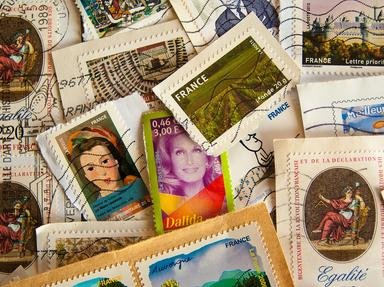Quiz Answer Key and Fun Facts
1. The enigmatic poet Emily Dickinson appears on this postage stamp issued in 1971. Dickinson was a prolific writer, with over 1000 poems to her name - which of these answers is one of Dickinson's most well-known poems, published posthumously in 1890?
2. This Russian stamp from 1965 shows a Jewish Bolshevik politician who was chairman of the All-Russian Central Executive Committee between 1917 and 1919. He was also one of the architects of the October Revolution and is thought to have been involved in the murder of the Romanov family. Who is he?
3. This French stamp from 1923 depicts Louis Pasteur, a French scientist. The process of pasteurisation was named after him, but what liquid was he working with when he developed the method? (Be careful with this one!)
4. Sportspeople often appear on stamps, and the sportsman on this Armenian stamp is Henrikh Mkhitaryan. What sport did he play?
5. This Irish stamp from 1957 shows William Brown, an Irish sailor and admiral. In which South American country, famous for gauchos, the tango and Lionel Messi, is he considered to be the father of the country's Navy?
6. The man on this stamp is Saparmurat Niyazov, a notorious dictator with a personality cult and an obsession with monuments. Of which former Soviet Union country, with the capital of Ashgabat, was he the President between 1990 and 2006?
7. This 1974 stamp is Indian but the man featured on it, Guglielmo Marconi, was Italian and the stamp commemorates the centenary of his birth. What device is he credited with inventing?
8. This stamp from the Seychelles comes from a series of stamps featuring African liberation heroes. The man depicted on the stamp is Patrice Lumumba. Of which country was he the first Prime Minister, before his dismissal by President Joseph Kasa-Vubu and subsequent assassination?
9. This Japanese stamp from 1959 commemorates the wedding of Michiko Shouda and the Crown Prince of Japan. As an Emperor, he reigned from 1989 to 2019 in a period known as the Heisei. Who was he?
10. This Jamaican stamp from 1938 was released during the age of the British Empire. The king pictured on it was also the final Emperor of India - but who was he?
Source: Author
Kankurette
This quiz was reviewed by FunTrivia editor
Bruyere before going online.
Any errors found in FunTrivia content are routinely corrected through our feedback system.
